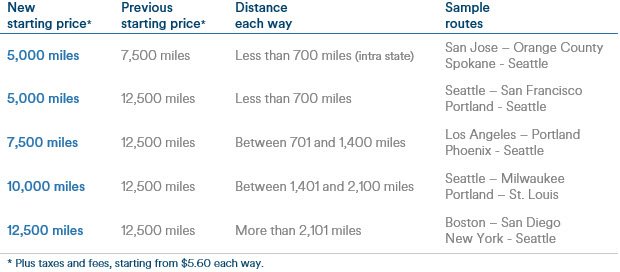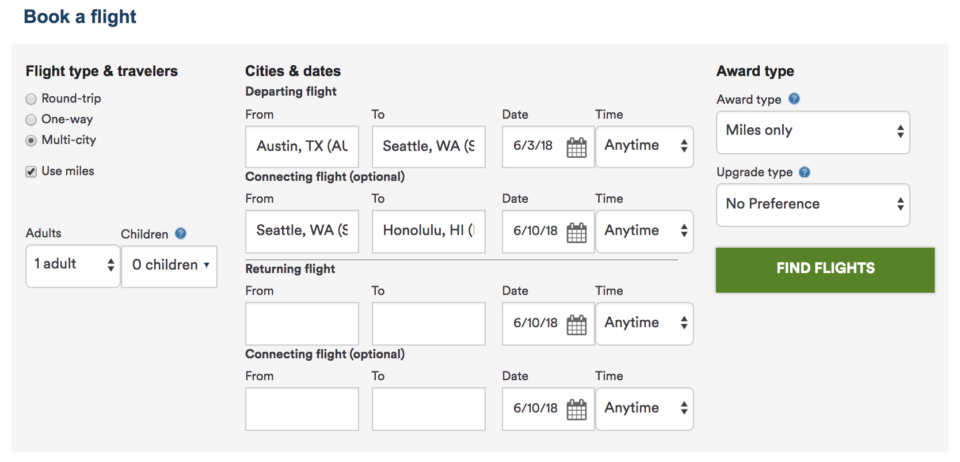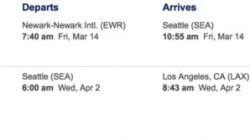Alaska Airlines adopted a cheaper award pricing for its award flights in December 2016. Today I’m going to explain how you can combine that with another, much older, Mileage Plan award trick to book two excellent flights for just 17,500 miles. You can apply the same strategies to many other kinds of award tickets. It’s especially good to remember in situations where you think you might be better off paying cash.
Amol wrote a similar post on the stopover rule years back, but with recent changes such as distance-based awards and upgrades on economy award tickets, I thought it was worth a refresh. Check out his article for an example of how to get three round-trip flights for the price of two.
Saver vs. Anytime Awards
You’re familiar with some airlines charging more for “anytime” awards that don’t have capacity restrictions. There are also “saver” awards that most of us hope to book. United has just these two prices. Delta has five (even though they’re all hidden). Alaska also has a range of prices. For travel to Hawaii from the continental U.S., you’ll pay anywhere from 17,500 miles to 30,000 miles one-way.
That 17,500 number is the saver award. Saver awards can be combined with other saver awards, but if you combine a saver award with an anytime award, you’ll pay the anytime price on the entire ticket.
Distance-Based Awards
Within the continental U.S., distance-based pricing comes into play. In December 2016 the airline decided to adjust this range between saver and anytime awards depending on how far you fly. You can pay as little as 5,000 miles one-way for travel under 12,500 flown miles.

The most expensive (i.e., longest) award flights in the continental U.S. start at 12,500 miles. You’re gonna want to know the lowest price because that, again, is your “saver” award and can be combined with other saver awards.
The Stopover Rule
My favorite rule is that Alaska Airlines allows a free stopover on every one-way award. Got a round-trip ticket? That’s essentially two one-way awards so you get a stopover in each direction.
Where you can put that stopover is a bit tricky. There’s no formal language, but essentially it’s limited to hub airports. So, Seattle is a hub (and so are San Francisco and Los Angeles, I bet). You can play around with it. If you run into problems combining flights, then this fuzzy rule is probably the reason.
I’m fortunate to live in Seattle.
Putting It All Together
My brother was planning to fly out to Hawaii with my sister and me for a family trip after I graduate from business school in June. I realized that I could combine his flight to Seattle for the graduation ceremony with our trip to Hawaii, essentially getting one free flight and doubling the value of our miles.
From Ft. Lauderdale to Seattle, an economy class award was available for 12,500 miles. From Seattle to Honolulu, three days later, an economy class award was available for 17,500 miles. These are both at the lowest level and thus combinable. Three days would normally be considered a stopover, and most airlines would price the tickets separately. Not Alaska. I paid 17,500 miles for the whole thing.
Perfect for Anytime Awards
In my brother’s case, there were saver level awards on both flights. But what if one flight only has “anytime” award space? Then you can go hog wild because you can add any flight in combination with the stopover and pay the same price.
There were only “anytime” awards left available if my wife and I wanted to take the same flight from Seattle to Honolulu, pushing economy to 30,000 and first class to 80,000 miles. To pay 80,000 miles one-way in first class is a lot anywhere in the U.S. But I’m moving to Austin, and I know I’ll have to do some travel back and forth.

I could book any flight from Austin to Seattle — pretty much any time before our trip to Hawaii — and create a stopover in Seattle. Then I’ll continue to Honolulu for my vacation. I can get both flights in first class for 80,000 miles or in economy for 30,000 miles. My Austin flight becomes free, making the Honolulu flight much more attractive even though I’m paying for a more expensive award with no capacity restrictions.
Another way to look at it is that I’ve used the rules to turn an anytime award into two saver awards. Austin to Seattle is 1,771 miles so the price starts at 10,000 award miles for a one-way ticket in economy class. That means I’m paying 20,000 miles (30,000 less 10,000) for the portion from Seattle to Honolulu — just a smidgen over the 17,500 cost of a normal saver award. Keep in mind I’m not actually buying two saver awards, but by using the stopover rule the cost of a single anytime award is about the same price.
Upgrades
Oh, yeah. Alaska now makes these anytime awards, which book into the Z fare bucket, upgradeable. (The cheapest award tickets are not upgradeable.) In fact, they have higher priority than all tickets except a full-fare paid seat.
Order of upgrades (from first to last): Y, Z, S, B, M, H, Q, L, V, N, K, G, T, R, W.
Going to Hawaii, there’s probably enough demand that we still won’t clear. But from Austin to Seattle, I probably will not have to apply any MVP Gold Guest upgrades.

